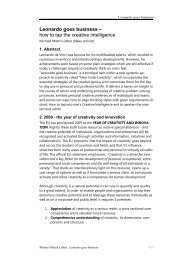Keynote speech - M.Sc. in Strategic Innovation & Future Creation
Keynote speech - M.Sc. in Strategic Innovation & Future Creation
Keynote speech - M.Sc. in Strategic Innovation & Future Creation
Create successful ePaper yourself
Turn your PDF publications into a flip-book with our unique Google optimized e-Paper software.
The development of clear goals that will guide the direction of the partnership<br />
Suitable structures accord<strong>in</strong>g to the demands of the respective development tasks<br />
Form of <strong>in</strong>tegration <strong>in</strong> correlation to contribution, the resources and the stage of the<br />
<strong>in</strong>novation process<br />
Relationship variables, <strong>in</strong> particular commitment and trust<br />
Communication for the enablement of coord<strong>in</strong>ation and supervision<br />
Two approaches describ<strong>in</strong>g the role of the customer <strong>in</strong> the <strong>in</strong>novation process stand out <strong>in</strong><br />
literature. Firstly, the works of Piller (2006) and Reichwald and Piller (2006,) which propagate<br />
hav<strong>in</strong>g one’s own open <strong>in</strong>novation approach with<strong>in</strong> the framework of <strong>in</strong>teractive value creation,<br />
should be referred to. Also of great importance are the explanations from von Hippel<br />
(1988, 2005) and the works <strong>in</strong> co-authorship (Herstatt, von Hippel 1992, Thomke, von Hippel<br />
2002) on lead users.<br />
4. Lead users and their special <strong>in</strong>novation potential<br />
In an open <strong>in</strong>novation process, the company <strong>in</strong>vites the customer to participate <strong>in</strong> the <strong>in</strong>novation<br />
process. While customer <strong>in</strong>tegration proceeds <strong>in</strong>tuitively <strong>in</strong> most companies (<strong>Sc</strong>hallock,<br />
Bad<strong>in</strong>g 2006), the lead user approach represents a concept of systematic <strong>in</strong>clusion of customers<br />
who have an aff<strong>in</strong>ity for <strong>in</strong>novation. Lead users represent a very active and suitable<br />
customer group for <strong>in</strong>tegration <strong>in</strong>to the <strong>in</strong>novation process (von Hippel 1986). Draw<strong>in</strong>g on von<br />
Hippel (1986, 1988, 2005), ord<strong>in</strong>ary customers are differentiated from lead users based on<br />
two attributes (Reichwald, Piller 2006):<br />
(1) Lead users have already had certa<strong>in</strong> needs for a long time, before these generally<br />
appeared <strong>in</strong> the market.<br />
(2) Lead users also have the ability to develop a fully-function<strong>in</strong>g solution that satisfies<br />
their needs.<br />
Thus, lead users have important characteristics that could be beneficial for radical <strong>in</strong>novations<br />
<strong>in</strong> particular. This is based on the premise that the customer is able to not only demand<br />
new services from an exist<strong>in</strong>g product, but also to use it <strong>in</strong> conjunction with someth<strong>in</strong>g new<br />
(Reichwald, Piller 2006). However, <strong>in</strong>cremental <strong>in</strong>novations can lead to a cost reduction of up<br />
to 80 percent and should not be underestimated. Radical <strong>in</strong>novations, on the other hand, are<br />
usually accompanied by a long-term competitive advantage (von Hippel 2005). But very few<br />
customers can play the role of a lead user with<strong>in</strong> this sector. Customers with these characteristics<br />
are rare and very hard to identify. For the concrete implementation of the lead user<br />
method, von Hippel (1986) recommends a four-step approach. In step one, the companyrelevant<br />
trend needs to be identified. Creativity techniques and trend research support this<br />
process phase. Characteristics for the customers to be found are thereupon def<strong>in</strong>ed. In the<br />
next step, lead<strong>in</strong>g customers with<strong>in</strong> the well-def<strong>in</strong>ed market segment are identified. The earliest<br />
possible recognition is thereby of importance for the success of the lead user project<br />
and the <strong>in</strong>tegration of the customers (Herstatt 2001). Not all of the attributes looked for will be<br />
comb<strong>in</strong>ed <strong>in</strong> one customer. The <strong>in</strong>novative product will predom<strong>in</strong>antly result from the sum of<br />
the <strong>in</strong>put from different lead users with specific characteristics. On the basis of customer ex-<br />
4



